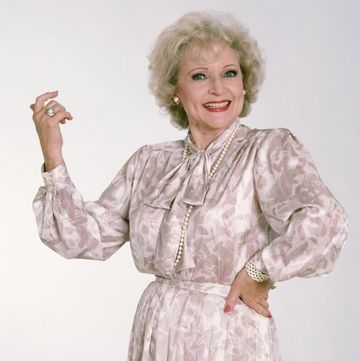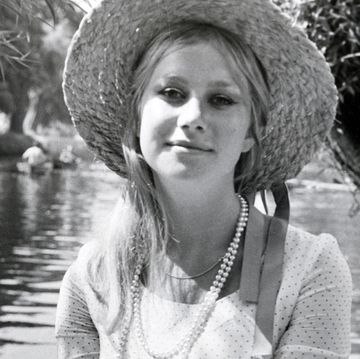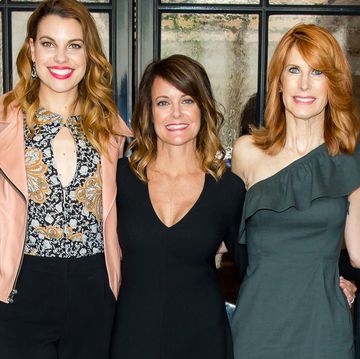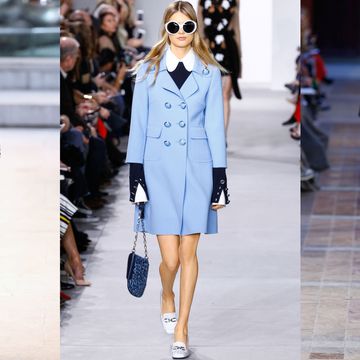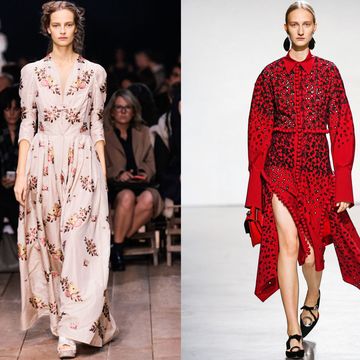Ask fashion editors whose style they most want to emulate and a great many will say "Charlotte Rampling." This tends to come with the display of an Instagram homage or three. There's the 1973 Helmut Newton portrait of Rampling naked on a dining table in Arles, the notorious still from 1974's The Night Porter (which Marc Jacobs nodded to in his Fall 2011 collection for Louis Vuitton), her face in Woody Allen's 1980 black-and-white Stardust Memories, and a world of images of Rampling—with her famous hooded stare—in tight sweaters, miniskirts, le smoking, and, then and now, nothing at all.
Which makes it more surprising that while Rampling has been master and muse for more than 40 years, she's a hoot. At 68, the stare is still there, and she's happy to deliver it on demand, posing sternly in her armchair at Paris's bourgeois Hôtel Lutetia. The hotel is a quick stroll from her home and studio in the Sixth Arrondissement, and she's a fast walker. She strides right past me in efficient Church's brogues, cloaked in a long black Louis Vuitton coat.
"Oh, that's nice," she says, once corralled, of the fanship of the fashion set. "You've not got a conscious vision of how you want to be seen. You just go about your life, actually." She attributes this pragmatism to being "an English girl. We've never been allowed to be too much into ourselves, you know? Like Kate Moss, for example, she's completely down-to-earth. She's just a good English girl."
With this, Rampling takes off a pair of lacy black gloves, fingerless, the fabric just covering the backs of her hands. They're totally on brand. "Ha!" she laughs. Her style revolves around mannish tailoring, with some sex in the sensibility. She owns an infinite number of tuxedos. "I must've worn them since Yves Saint Laurent's first year," she remembers. "He was putting women into these wonderful men's clothes and tuxedos, long pants, wide pants. He wasn't the first, but he put it into the modern world." As did Rampling. She sat for the photographer Jeanloup Sieff (who took the iconic naked portrait of Saint Laurent) and decided that suiting, "well, suited me. They're sort of my style. I'm not a dress girl."
She was once, of course. The young Rampling knew she was fetching. "I never wanted to be a big star," she says, "but I wanted to be something." In early 1960s London, she was working at an advertising agency in a "typing pool. I wasn't even a secretary. And then a big executive saw me." Knowing look. "That's usually how it works for us girls. You have to make do with what you've got."
From there it was a fast track to Babe Town: 1966's Georgy Girl, TV's The Avengers. But Rampling had a taste for the subversive. First, she decided against living in Los Angeles. "I dipped in and out from '69 to '75, but I wasn't prepared to really sacrifice my life for it," she says of Hollywood. "I just wanted to live differently." Then came the provocation—the Newton shoot and The Night Porter, in which she played a concentration-camp survivor in a sadomasochistic relationship with a former Nazi officer, among other radical choices.
Rampling moved to France in 1976, as "sort of an It girl," she says. "I'd done the right sort of moves, a bit of this and a bit of that. I got away with a few sort of interesting … " Nudges and winks? "Yes! Nudges and winks," she adds, "to make me a little bit spicy."
Pause for a moment to enjoy how Rampling says "spicy": sotto voce and extra sauce. "Tell the girls it's a recipe that Charlotte recommends." She chuckles. "Anyway, I fell in love with Jean Michel [Jarre, the French composer she married in 1978, the second of two husbands], and I spoke French. I felt very comfortable here." She had two sons, Barnaby (with first husband Bryan Southcombe) and David, "so France became the family home." She continued to work in the U.S., however, most notably as Woody Allen's ex-girlfriend in Stardust Memories and as Paul Newman's lover and rival in 1982's The Verdict.
Like the cliché of the French girl, though, Rampling has always been cool. She doesn't see herself that way, "but I know how I can be," she says. "I know what I can push on, what vibe I can give out. I know the power I have in different areas."
Tell Rampling she's "fabulous at every age" and she laughs. "Oh, the things you magazines come up with!" Her great currency is that she hasn't done anything to her face, which wears the years as elegantly as she wears her lace gloves. Of surgery, fillers, and the like she says: "It's not the old cliché about the face staying still; it's that you lose the register. You lose the map. Your face is your expression—you make your worth." And Rampling is still hugely prolific (she starred in François Ozon's Swimming Pool in 2003, and Lars von Trier's Melancholia in 2011),and after finishing up a guest role in Dexter last year, she's planning a stint in London to make 45 Years, a film about "what people my age face. It's about a couple who've lived together a long time, and something happens that challenges your point of view about your life."
She will acknowledge that it's easier to age in Europe than in the U.S. "There's a pressure there [in America]," she says. "If you're going to be a sheep and follow everybody, do it. Become another fabricated face. It's heartbreaking. Beautiful faces of young women, you know?"
So what is sexy? "That's not as easy." She scans the roomful of businessmen. "Hmm. Sexy to me is about a sparkle. Now, all of these people, they're doing their thing. But maybe one of them, if they looked at me, they would put on the sparkle. You know, juicy, sexy sparkle." Burst of laughter. "Nobody is looking at us, I might add."
But, of course, there's one image of Rampling that is burned into the collective retina: Helmut Newton's Arles portrait. "It was the first time I'd ever met Helmut," she recalls. "He came down to Arles, where I was doing a film called Caravan to Vaccarès, to shoot me for Playboy. I'd said, 'I don't want to do nudes,' but the producers said, 'We're sending this very good photographer; you can have control of the pictures.' So we did it. Playboy was just a nice picture of me, naked from the back and sitting on a chair. Then Helmut said, 'Can we now do a nude—our nude?' Could I come to this fantastic room, where the matadors dressed. 'Could I take an hour of your life?' So I threw all my whats to the wind."
A print of the photograph sits in Rampling's garage. "Helmut wouldn't give me any, so I stole one! He loaned me one and I didn't give it back. It's for my grandchildren." A gleam returns to those hooded eyes. "In case you forget where you came from, little boys."


